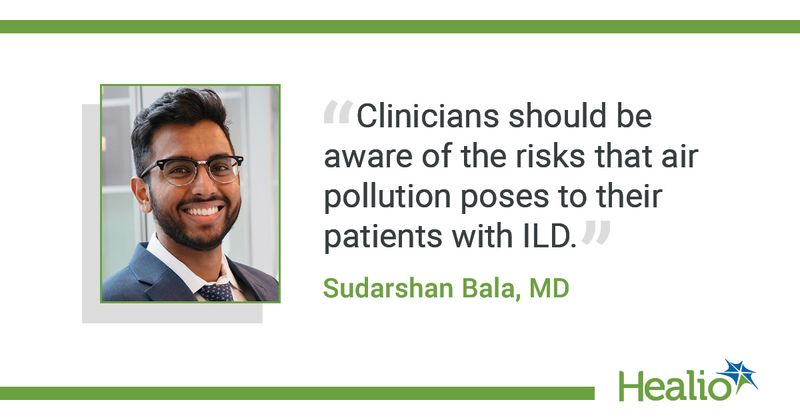High levels of air pollution linked to ILD prevalence, acute exacerbations, death
Key takeaways:
- Particulate matter exposure was linked to interstitial lung disease incidence, acute exacerbations and death.
- Gaseous pollutant exposure was mainly linked to acute exacerbation of interstitial lung disease.
WASHINGTON — Exposure to air pollutants at high levels contributed to interstitial lung disease incidence, acute exacerbations and death, according to an abstract presented at the American Thoracic Society International Conference.
“It was interesting to see that the evidence to date suggests that greater exposure to air pollutants is more consistently associated with acute exacerbations of ILD than mortality,” Sudarshan Bala, MD, resident physician at the University of British Columbia, told Healio. “While both gaseous and particulate matter pollutants have been associated with both outcomes in various studies, this difference is most striking with gaseous pollutants compared to particulate matter pollutants. Overall, this is an area that has not been fully explored and more studies are needed to understand the complex relationships between multiple gaseous and particulate pollutants that contribute to the risk of ILD exacerbations and mortality.”

In a systematic review of three databases, Bala and colleagues analyzed 21 studies that assessed air pollution in relation to ILD and interstitial lung abnormalities (ILA) incidence, changes in lung function, acute exacerbations of ILD and mortality to understand how air pollutants impact these outcomes.
Several different methods were used to estimate patient exposures to air pollution in the evaluated studies. Most studies used either a surface monitoring station close by (7 studies) or a hybrid mix of monitoring methods that often incorporate ground-based monitors, satellite data and chemical modelling approaches (8 studies), according to Bala and colleagues. Fewer studies used interpolated surface monitoring (2 studies), monitoring by external bodies (2 studies) and satellite-only monitoring (1 study).
In this review, researchers found that elevated air particulate exposure levels were linked to more cases of ILA and ILD. For example, in patients with rheumatoid arthritis, the incidence of ILD was greater in patients exposed to higher levels of organic matter and black carbon PM2.5 constituents as compared with other particulate matter constituents, Bala and colleagues told Healio.
With regard to the effect of air pollution on changes in lung function, several studies included in the abstract found that baseline and future measures of FVC and diffusion capacity of the lung for carbon monoxide (DLCO) decreased with exposure to both gaseous and particulate matter pollutants, according to Bala.
Further, researchers found that if an individual was exposed to high levels of nitrogen dioxide, sulfur dioxide and particulate pollutants, they had an increased incidence of acute exacerbations of ILD.
Researchers also observed a link between more exposure to particulate pollutants and heightened mortality rates in many of the included studies. Notably, human derived constituents of PM2.5, such as sulfate, ammonium and black carbon showed the largest effect estimates in one large North American study featured in this review, according to Bala and colleagues.
“Overall, the data from this systematic review show that exposure to air pollutants can adversely impact the development, progression, incidence of acute exacerbations and mortality in patients with ILD,” Bala told Healio. “Further stratifying these air pollutants into their constituent components reveals that different gaseous and particulate matter pollutants can have varying impacts on these adverse outcomes, which has important clinical and lifestyle implications for patients living with ILD. Clinicians should be aware of the risks that air pollution poses to their patients with ILD, advocating for stricter environmental health regulations to protect these vulnerable groups and informing patients about personal interventions they can take to mitigate their individual risk.”
Since only four out of the 21 studies broke down PM2.5 and PM10 into constituent components, Bala told Healio more attention on air pollution composition is needed in future studies.
“Future studies will need to focus on the complex interactions of particulate matter constituents and gaseous pollutants to provide a more comprehensive understanding of how air pollution as a whole influences the development and progression of ILD,” Bala said. “Future research should also explore the molecular mechanisms underpinning associations of air pollution with adverse outcomes in patients with interstitial lung disease. Lastly, the research to date on air pollution impacts in ILD has been very North America-centric, so more global initiatives to investigate the association of air pollution with ILD incidence and mortality is critically needed.”
For more information:
Sudarshan Bala, MD, can be reached at sbala156@gmail.com.

